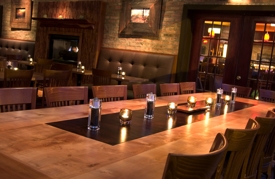Uncommon Ground, the North Side eatery with two locations known for its local, organic food and sustainable practices, just raised the bar on how green a restaurant can be.
The Green Restaurant Assn. this week named Uncommon Ground’s Devon Avenue location the greenest restaurant in America after owners Helen and Michael Cameron implemented 116 environmental features, including solar panels, Energy Star dishwashers, LED lights, and tables made from fallen trees. Those steps and more earned them a 4-Star Certified Green Restaurant rating by the Boston-based non-profit, which has a reputation as a rigorous third-party auditor.
Uncommon Ground’s Clark Street venue in Wrigleyville was named the second-greenest restaurant in the country, also with a 4-Star rating from GRA, but about 25 fewer points than its sister restaurant on Devon. The Camerons recently purchased the Clark Street building where they have been operating for 20 years; they plan to install solar panels there next year.
Ironically, the Devon location has the country’s first certified organic rooftop farm in the country, but didn’t get any points from GRA for that endeavor because there isn’t a category yet for that feature. A rooftop garden is planned for the Clark Street site next year.
The GRA has certified 450 eateries nationwide, but only three others aside from Uncommon Ground’s two sites carry the 4-Star ranking.
At an awards ceremony earlier this week, the Camerons were presented with a plaque by GRA’s chief executive officer Michael Oshman, followed by remarks from Karen Weigert, the city of Chicago’s chief sustainability officer, about progress in the overall local green economy. Dan Rosenthal, founder of the Green Chicago Restaurant Coalition, applauded the Camerons’ efforts and noted his organization awards local eateries a Guaranteed Green designation if they are certified by GRA or Green Seal, another green auditor based Washington, D.C.
Crain’s met with Helen Cameron before the award ceremony to learn more about the challenges of running a green restaurant.
Crain’s: Why was it important for you and Michael to get a green certification?
Ms. Cameron: We decided to get involved in certification with the Green Restaurant Association because of conversations with Dan Rosenthal at the Green Chicago Restaurant Coalition. We realized there are lots of restaurant owners that say they’re green, but it was clear to those of us who do it on a daily basis that not all are walking the walk.
After going through the first level of certification (in 2010), we realized the potential for even greater cost savings and running our business more efficiently if we took it to the next level. Sometimes I’m spending more on some items, like chemicals for cleaning, or the organic food that comes from local sources. But these are basic ideals and principles that have been interwoven into our values since the get-go. The certification process gave me a greater scope of understanding sustainability now that I’ve gone down that rabbit hole.
Crain’s: Is it tough to be green in the restaurant business?
Ms. Cameron: I’ve been trying to be green over the span of many years of owning our restaurants. There’s so much to know about equipment, water efficiency, energy use, sustainable furnishing, paper products, buying local food, and all the chemicals and cleaning supplies we use. You have to research all the stuff you’re buying to know whether or not it’s the right product. If you replace a product for something greener, will it be cost effective? We buy a lot of our green supplies through the Chicago Green Restaurant Coalition’s group purchasing program.
Crain’s: What are some of the most challenging elements about getting accredited by GRA?
Ms. Cameron: One of the biggest challenges is time. I would block entire days off to work fully on documenting and putting everything in order to send to the GRA. They don’t do on-premise inspection, but they demand invoicing to verify we’re doing what we say. When purchasing invoices aren’t available, I have to do even more. I have a heat exchanger that came with the Devon Avenue building when we bought it. It’s more energy efficient and we knew we’d get points for it. So I had to take photos and send invoices of repairs to prove without a doubt that it was there.
Crain’s: You got the GRA’s 3-star rating last year. What more did you have to achieve to get that coveted 4-star rating?
Ms. Cameron: We needed more substantial points for the 4-star rating, so we changed our dishwashing systems to Energy Star-rated machines. The chemicals that go with those machines put us into a greener zone, because we’re using compact dry products that get reconstituted with water so the shipping weighs less and the product has less packaging. The machines also use less water and energy. All that has a cumulative effect in the number of points we get.
We also moved to the highest rated ice machine that uses less energy and water. And we switched our electric supplier to Blue Star Energy, a renewable energy company. Now the energy we buy is green wind power produced in the U.S.
Crain’s: What were some of the big cost savings you achieved by switching to greener practices?
Ms. Cameron: Installing solar panels was a big upfront investment, but state rebates gave me 50% of it back and we’re estimating the total payback will take only 3.5 years. The panels provide us with about 10% of our energy needs and with the sun heating my water, I’ll be saving $5,000 to $6,000 a year on my gas bill. After the payback, it will be all free and clear savings. If gas prices go up, my savings will be even higher.
One savings that was unexpected was switching to accelerated hand dryers from paper towels. I installed three in each restaurant and the overall expense was about $1,500 per restaurant. Afterwards, I realized I was saving $1,000 a month in each restaurant on paper towels I didn’t have to buy anymore. It paid itself off in about two to three months and now I’m saving about $1,000 a month. Also, if I’m not buying paper towels, they’re not being made for me, shipped to me, or going into the garbage or the waste stream. It’s a much greener way to go.
Crain’s: You must get lots of points for your aggressive local sourcing for food and drink products?
Ms. Cameron: Yes, one of our most important missions is buying local food and beverages. We try to buy hyper-local whenever we can from sources less than 100 miles way.
While we do have some imported tequilas and scotch, we’re only buying items like wine, vodka, gin and rum that are produced in the U.S. We buy Rain Vodka that’s produced with grains that come from the Midwest. We’re trying to provide a market for local people so they can be sustainable too. Why would I buy Russian vodka when our grain gets sent to them and then they ship it to us? It’s a very inefficient business model. Keeping our money in the local economy is very important to us and we’re building a network of like-minded producers.
Crain’s: What are your future plans for continued greening efforts?
Ms. Cameron: We have plans to install an iGo Car Sharing charging station at the Devon Avenue location and get the solar panels up and running on Clark Street next year. We’re also going to start a brewery next year in Chicago to make super-hyper-local beer. We’re operating at a high level of sustainability so there’s not really a whole lot more on a large scale that we can do.



